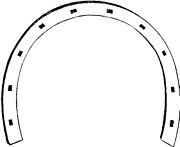only needed to sustain the wall; the shoe should also be flexible.
As is customary, the excess of crust should be removed, observing, however, to leave a little more than usual in order to imbed the semi-circle in it; then to apply this, a groove is made in the middle of the wall of the foot to the depth of the shoe, so that it may lie therein, and the outer edge of the crust project beyond it all round, to facilitate its being worn on the road. The two ends of the shoe ought to be incrusted in the heels, as this is productive of two mutual advantages: one, that the wall should preserve the thin shoe from too rapid wear, and the other, that the shoe prevents the hoof from breaking, or too much attrition (fig. 185). This mode of shoeing is advantageous for saddle-horses; it would be also good for draught-horses, did the shoes stand wear long enough, I have seen many horses go with these shoes for three weeks; of course, the less work they did the longer the shoes would last.
I may mention, however, that there is a more convenient mode of shoeing draught-horses; this is with a shoe that is bedded (enclavé) in the whole thickness of the wall, observing to leave it projecting in its entire contour. This shoe may be termed le croissant enclavé (the imbedded


